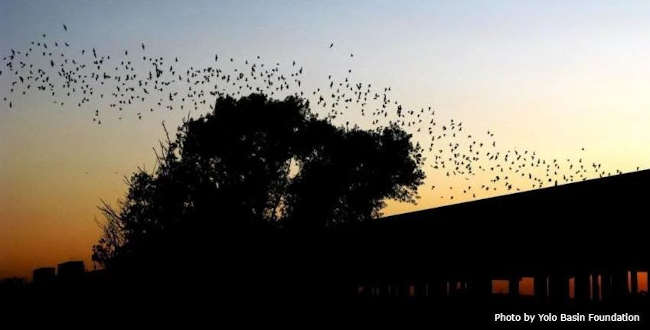
Why do bats live under the I-80 Yolo Causeway near Davis?
Q: Why do bats live under the I-80 Yolo Causeway near Davis instead of a more natural setting?
A: It is pretty amazing that around 250,000 Mexican free-tailed bats choose the Yolo Causeway as their home. There are several reasons why they do so, says Yolo Basin Foundation Program Coordinator Corky Quirk. First, Mexican free-tailed bats like heat and temperatures under the Yolo Causeway are warm and stable. The asphalt and causeway deck provide additional warmth. Second, the bats can keep relatively safe from predators by nestling in the causeway's expansion joints and crevices. However, the causeway isn’t totally protected. Predators sometimes hang out under the causeway to prey on fallen bats, especially during birthing and juveniles’ first flights. Peregrine falcons may also show up to hunt bats in the air. Third, bats choose the Yolo Causeway as their home because of its proximity to food. There are foraging opportunities nearby and the adjacent wetlands and rice fields are a good source for insects. The causeway is also just a short bat flight away from farm fields and orchards in Yolo and Sacramento counties.
Habitat loss may also be a factor as urbanization has reduced natural roosting locations such as hollow trees. In fact, the Yolo Causeway may have attracted bats from other areas by providing a safe, warm roosting place.
For more information on the Yolo Causeway bats visit the Yolo Basin Foundation’s website.
Crab casting
Q: Can I crab using a rod and reel with a trap attached to my line?
A: No. This style of trap, commonly known as a crabhawk or crabjaw trap, is sold in many places and our wildlife officers have encountered anglers using them. However, they are not legal in California because they are not listed as a method of take for saltwater crustaceans. California Code of Regulations, Title 14, section 29.80 lists approved methods of take for crabs which include taking by hand, crab loop traps (snares), hoop nets and traps.
Airbow hunting
Q: Can I hunt in California using an air gun that shoots arrows via pressure?
A: No. The device you’re referring to is often called an airbow, which is essentially an air gun that shoots arrows. An airbow is not considered a firearm and does not fall under the definition of a bow or crossbow outlined in California Code of Regulations (CCR), Title 14, section 354. Game mammals and birds may only be taken in California by methods listed in CCR, Title 14, sections 311, 507 and 353. Because an airbow does not fall under any of these sections, it may not be used to take game animals in California.
Lobster claws
Q: Is it true that California lobsters don’t have claws?
A: Yes, it’s true. The California spiny lobster is a species of lobster that does not have claws. In fact, there are far fewer clawed lobsters than spiny lobsters, says CDFW Environmental Scientist Jenny Hofmeister. Out of all the lobster fisheries in the world, there are only a few that target clawed lobsters. Most lobsters are spiny like the species that live in California. However, as the name suggests, California spiny lobsters are covered in spines. This feature presents its own unique challenge for scientists who work with the species. Scientists don’t have to worry about claws when handling lobsters for conservation purposes, but they do have to watch out for their spines!
California’s spiny lobsters are a rocky reef kelp forest species found mostly off the coast of Southern California in shallow waters to a depth of about 300 feet. For more information watch CDFW’s Introduction to Lobstering video or visit the department’s recreational lobster fishing web page.